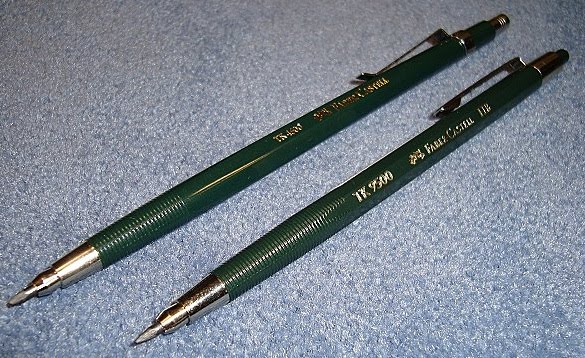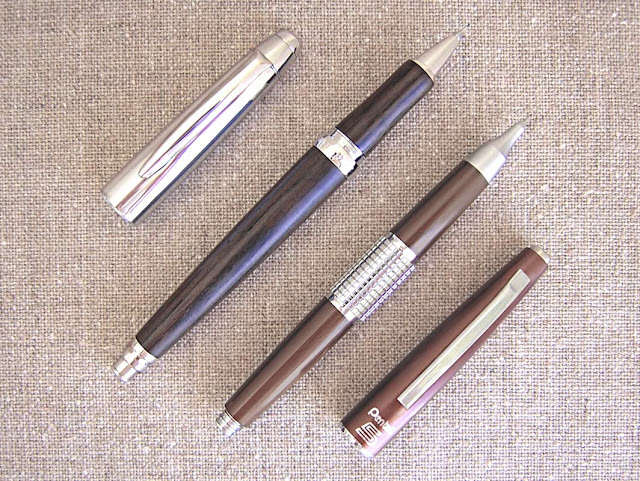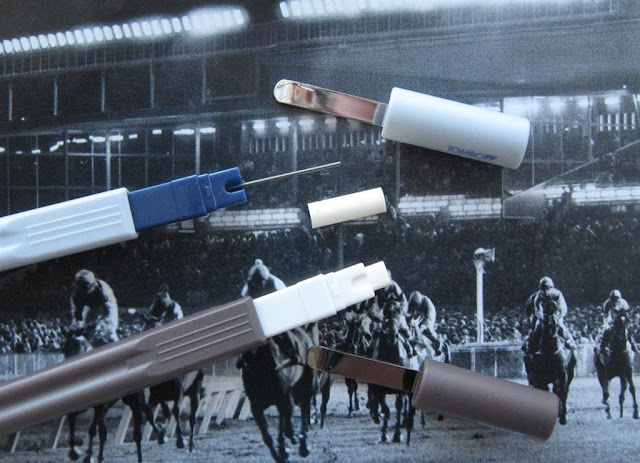Metaphys VISS 44050 Eraser Review
I first saw the Metaphys VISS eraser back in 2008 on the ISOT (International Stationery and Office Products Tokyo) Trade Fair website, and it immediately caught my attention.From what I can make out, Metaphys are a design cooperative that partner with a range of manufacturers and distributors to design products that the partner then sells under the Metaphys brand. A consortium brand as it were. In this case the Viss eraser is in partnership with フエキ Fueki (Fueki Nori Kogyo Ltd) a company whose primary business is apparently industrial glues and adhesives, but who also have some presence in the stationery market, particularly products for the construction industry, e.g. carpenter pencils.
The idea behind the Viss eraser is simple. We all know that the nice sharp corners of a block eraser quickly become rounded and far less useful. The screw thread or spiral design of Viss means there is always a sharp edge available, or at least that’s the theory.
The Viss is somewhat similar in size to your standard block eraser – it is about 58mm long and 15mm diameter. At the time of writing it is available in white, orange and black. Metaphys state it is made from “elastomer resin” so that probably means it is what many others would call a “PVC-free and latex-free” eraser.
In keeping with the premium stationery concept the Viss comes in its own little clear plastic container.
Anyway, earlier this year I finally got around to getting a few of these Viss erasers to try. First off then, the spiral design provides an interesting sensation for your fingers every time you use it. An eraser and a fingertip massager all in one?
The main design concept of the Viss is that the spiral means you will always have a sharp edge available. Well, that’s a bit of a yes and no. If you hold the eraser at a relatively horizontal angle to use the edge as a thin line eraser then you will quickly wear down or blunt the peaks of the spiral. On the other hand, if you hold the eraser at a relatively vertical angle then you can use the outside edge of the spiral as the end point of what you are erasing. By that I mean you can easily erase up to a fairly well defined line from one side. The same as if you only ever held your block eraser perpendicular to the paper and just wore its end down without rounding the corners. It would still be a big fat eraser, but you could easily run the edge up to a controlled point when erasing. I think that’s the advantage of the Viss eraser, its design makes it much easier to do that. Much easier to hold it relatively perpendicular to the paper and erase up to a set point. It’s great for precisely erasing the first or last letter of a word, or even an entire word, but not so good at erasing a letter out of the middle of a word. Don’t get me wrong, you could make a reasonable attempt at erasing a letter from the middle of a word, by orientating the eraser horizontally to use a peak of the spiral but your vision is a bit restricted and the edges will blunt if used thus frequently. Of course you can re-sharpen them to some extent by later using the eraser vertically. All that aside though, long term, the spiral edges are never going to be as precise as a fine core stick eraser like Tombow Mono Zero, but they are sort of halfway between that and a traditional block eraser.
The eraser waste of Viss twists up very easily into strands. Actually it twists up better than most.
When you are doing some heavy erasing though it sometimes feels as if the eraser compound is starting to tear, or maybe even partially melt from the heat of surface friction? The eraser waste can bunch up too much and the surface of the eraser can be left looking a little torn or hairy.
Right then, time to get serious and head on down to the lab and get our highly expereinced staff to put Metaphys Viss to the test against our benchmark eraser, Staedtler Mars Plastic.
 |
Well, that’s a draw.
Let’s try again, this time really pressing the pencil lead hard into the paper to make it much heavier and darker.
Again, pretty even, but perhaps Mars did a very slightly better job.
Next then let's try some wooden pencils, starting with two coloured pencils.
A clear but narrow victory to Mars. Basically Mars feels ever so slightly more abrasive in use and I imagine this was the secret to its success here.
Now wooden HB grade lead.
Another draw! Well maybe Mars was an absolute fraction better. But only maybe.
Lastly then wooden 5B lead.
Interesting. Mars certainly smears the lead about more. Overall it’s very close yet again, but if forced to choose a winner I think Mars erased better by a very small margin.
Frankly, I am surprised. I used Viss for several weeks and I thought it had only average erasing power, and that Mars would clearly be superior when they went head to head.
Overall then, I am very glad I spent my money to fly a couple of Metaphys Viss erasers across the ocean to my letterbox. Earlier in this review I described the Viss as “sort of halfway between that [Tombow Mono Zero] and a traditional block eraser”. Well being halfway between those two is a pretty good place to be. The Viss eraser looks cool, feels interesting in your hand, erases well, and the spiral design means you always have a reasonably sharp edge available. Get one and check it out for yourself.































.jpg)















